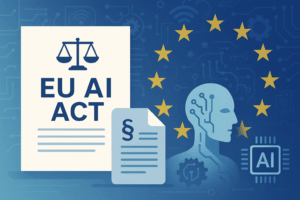AI adoption in the financial sector is accelerating. From credit scoring and fraud detection to algorithmic trading and customer profiling, financial institutions are deploying artificial intelligence at scale. But governance has not kept pace—and with the EU Artificial Intelligence Act (AI Act) entering into force, this disconnect is creating urgent compliance risks.
The EU AI Act establishes a risk-based regulatory framework, and many financial-sector use cases qualify as high-risk. This means mandatory documentation, transparency, and oversight obligations. Failure to comply could result in fines of up to €35 million or 7% of global turnover. Yet surveys show that many financial services firms lack even the basic elements of an AI governance framework.
The question is no longer whether AI is transforming the industry—but whether firms are prepared to govern it properly.
Governance Gaps Persist in Financial Services
Despite widespread adoption of AI tools, most financial services firms are underprepared for upcoming regulatory requirements. According to a survey by ACA Group and the NSCP, only 32% of respondents had established a formal AI governance committee. Few firms had written AI policies in place, and even fewer had implementation strategies or staff training to support responsible AI use.
These findings are echoed by Capco’s analysis of AI governance post-AI Act, which identifies a persistent lack of system inventory, risk classification procedures, and traceability protocols in financial institutions. In short: while AI is being deployed rapidly, oversight mechanisms remain fragmented or non-existent.
The risk is especially high for customer-facing and decision-automating systems—such as algorithmic credit assessments or AI-enhanced compliance checks—which are not only technically complex but also legally sensitive.
What the EU AI Act Requires from Financial Institutions
The AI Act introduces a classification system based on the level of risk an AI system presents to health, safety, or fundamental rights. Applications commonly used in financial services—such as creditworthiness assessments, anti-money laundering systems, and biometric identity verification—are explicitly listed as high-risk systems under Annex III of the regulation.
For these systems, financial institutions will be required to:
- Implement a risk management system covering the entire AI lifecycle.
- Maintain detailed technical documentation.
- Ensure human oversight of automated decisions.
- Complete a conformity assessment before putting the system into service.
- Register the system in the EU’s AI database.
- Log activities and make outputs traceable and auditable.
In addition, where high-risk AI systems process personal data, institutions must ensure GDPR compliance. This includes appropriate legal bases for processing, strict access controls, purpose limitation, and—where necessary—data protection impact assessments. The Goodwin law firm notes that the interplay between GDPR and the AI Act adds a layer of complexity for organisations that rely heavily on customer analytics.
The penalties for non-compliance are significant. As confirmed by both BABL AI and Holistic AI, breaches involving high-risk AI systems can result in fines of up to €35 million or 7% of global annual turnover, depending on the nature and severity of the infringement.
What Businesses Should Do Now
Many financial firms are still in the early stages of AI governance maturity. To comply with the EU AI Act—and to minimise legal and reputational risks—they must move quickly to formalise governance structures and documentation processes.
Key actions to take include:
- Create a complete inventory of AI systems.
This includes both internally developed and third-party tools. Record the purpose, input/output data, business function, and whether the system meets the high-risk criteria. - Develop internal AI policies.
Policies should outline who can build, buy, or deploy AI systems, under what conditions, and with what documentation. Include provisions for transparency, fairness, vendor risk, model monitoring, and human oversight. - Assign governance roles and responsibilities.
Establish an AI oversight function, such as a dedicated compliance officer or AI ethics board. Ensure they are empowered to enforce policies, approve deployments, and respond to incidents. - Implement AI-specific risk assessments.
Conduct structured assessments before deployment of any high-risk system, covering data quality, bias, cybersecurity, human control, and unintended outcomes. - Train relevant staff.
The AI Act encourages AI literacy. Use role-specific training to raise awareness among developers, compliance staff, procurement teams, and business leaders. - Ensure alignment with GDPR.
Where AI systems process personal data, verify compliance with the GDPR. That includes verifying data minimisation, legal basis, transparency, and international transfer mechanisms. - Maintain documentation and audit trails.
Store logs, risk assessments, design decisions, model updates, and incident reports in a centralised repository, accessible for internal and regulatory audits.
Practical Compliance Checklist
The following summary provides a high-level compliance roadmap:
- Map all AI tools in use; assess their purpose, data flows, and risk level
- Define internal policies on development, deployment, oversight, and vendor management
- Appoint an AI compliance officer or governance committee
- Conduct structured risk assessments for each high-risk system
- Train staff on AI risks and compliance responsibilities
- Ensure GDPR compliance for personal data used in AI systems
- Maintain logs, documentation, and conformity evidence
- Register applicable systems in the EU AI database
From Compliance Gap to Strategic Advantage
AI regulation is often viewed as a barrier—but the EU AI Act also provides a blueprint for responsible innovation. Organisations that implement sound governance not only reduce their legal risk but also improve transparency, customer trust, and internal control.
As EY emphasises in its AI Act readiness guide, the long-term advantage lies in integrating governance into the core of business strategy. For the financial sector, this means treating AI not as an unregulated experiment, but as a regulated function—subject to the same expectations as cybersecurity, AML, or data protection.
The coming year is critical. By acting now, firms can build a defensible, future-proof AI governance framework that aligns with both the EU AI Act and broader risk management priorities. Those that delay may find themselves not only out of compliance—but out of step with regulators, clients, and markets.






